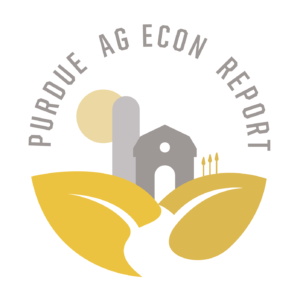Small Corn Crop Means High Prices
October 23, 2011
PAER-2011-18
Chris Hurt
Corn remains the crop in shortest supply after a difficult growing season. A disagreeable spring and summer in 2011 cut Indiana yields to just 145 bushels per acre, the lowest corn yields since 143 bushels per acre in 2003. Total state production will only reach 826 million bushels, barely enough to meet internal usage in the state. As a result, there will be little corn shipped out of the state this year.
Nationally, yields were estimated at 148.1 bushels, compared to an expected yield under normal weather conditions of about 162 bushel. Total U.S. production will be only 12.4 billion bushels, down compared to a usage base of 13.1 billion bushels for the 2010 crop. The limited supply of corn means that prices must be high to force cutbacks in usage of about 300 million bushels. Ending stocks are expected to be reduced to 6% of usage in the U.S. and to 13% for the world. Both are extremely low.
Given strong expected demand for ethanol, this means that usage reduction will be in the export market and in domestic feeding.
The small Indiana crop means there will be more storage space than crops to fill the bins. Our estimate is that about 14% of the state’s storage capacity will not be used this year. Of course the areas that have the poorest corn yields will have the greatest unused storage. In general, storage space will be readily available this fall in Indiana, and some commercial elevators and processors may reduce their storage charges to try to encourage more bushels to move to their facility.
Abundant storage space also means basis bids at harvest are expected to be strong. Basis is expected to be 15 cents to 20 cents stronger than in a normal yield harvest. Those premium basis levels are likely to continue throughout the marketing year.
USDA is estimating a season’s average U.S. price received of $6.70 a bushel at the mid-point of their estimate. The sharp price declines after the release of the September 12th crop report have largely been attributed to concerns over weakening world economic growth and a stronger dollar. Less income means weaker demand for agricultural products. The experience from the 2008 economic collapse is also causing some to have grave concerns in the grain markets. After the collapse of Lehman Brothers in mid-September, the December 2008 corn futures fell from about $5.50 a bushel in mid-September to as low as $3.00 a bushel by December.
Will corn prices recover? The answer to that question will come when end users start to become more aggressive buyers at lower prices. Then some recovery in corn prices can be expected. From a historical perspective, the nearby corn harvest futures have never been above $6.00 a bushel at harvest time.
The current carry in the market (higher bids through the marketing year) suggests there will be enough price gain to offset the costs of on-farm storage. Those bids are currently showing about a 25 to 30 cent per bushel gain above interest costs into the late-spring and early-summer of 2012. On the other hand, for commercial space, the carry in the current market is not large enough to cover interest costs and the cost or commercial storage fees that were used last year. As mentioned, commercial elevators may reduce their charges in some areas.
Expect another movement toward more corn acres in 2012, as planted acres will need to rise by 2-3 million. Market prices for 2012 will give large premiums to consider more corn acres as compared to wheat and to soybeans. More corn acres will mean more corn-on-corn acres. In Indiana in 2011 there were 5.9 million acres of corn planted relative to 5.3 million acres of soybeans.
